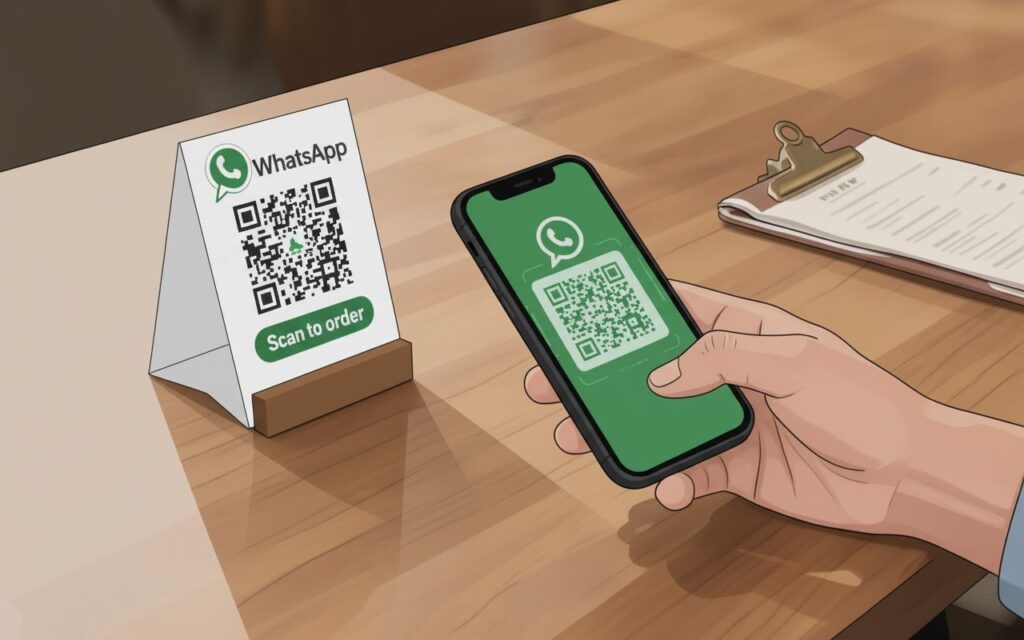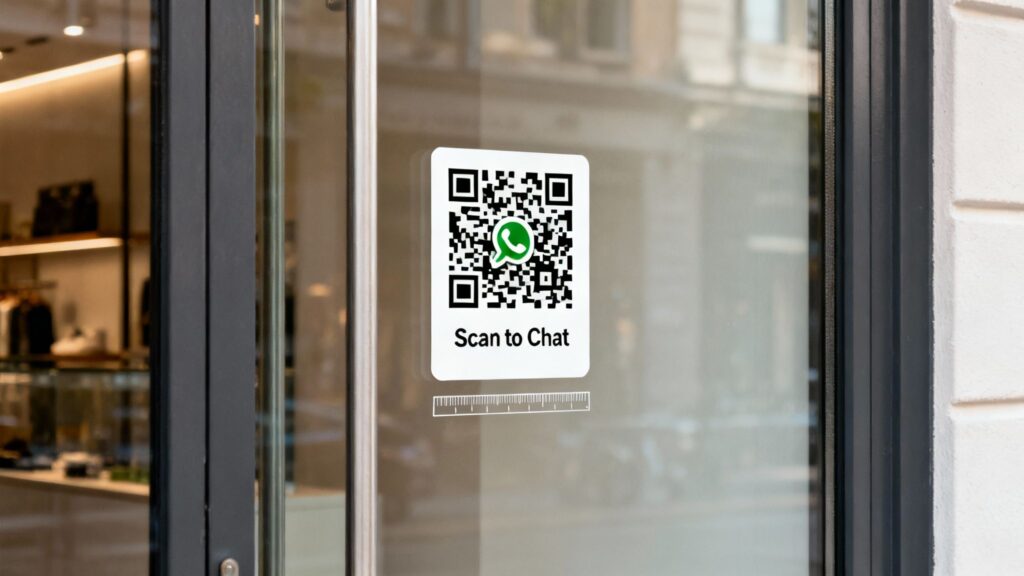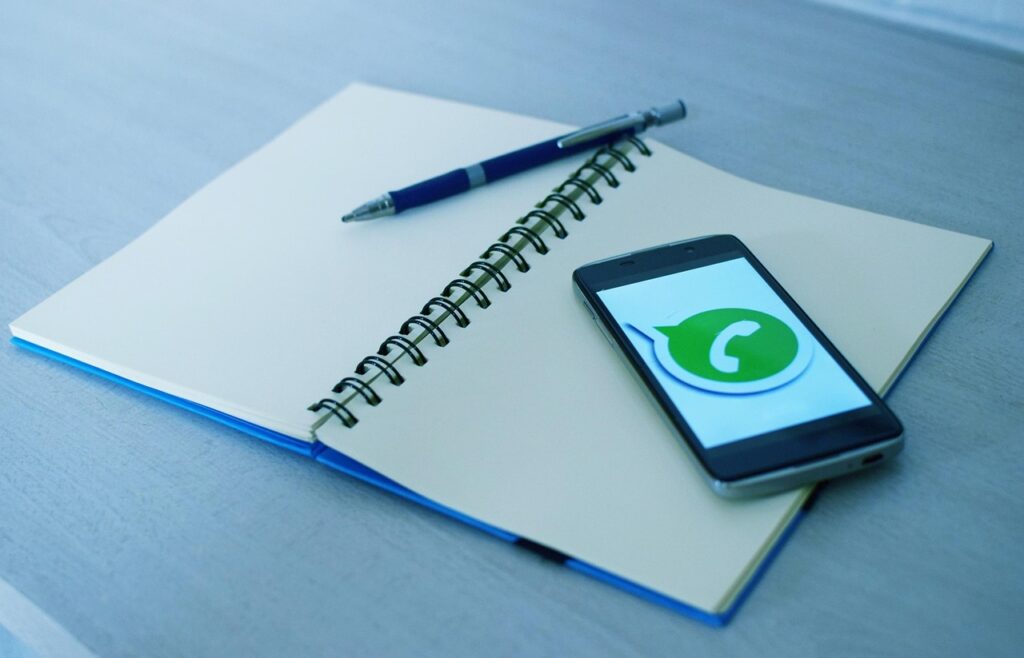A WhatsApp QR code is a scannable image that acts as a direct link to a WhatsApp chat. Instead of someone needing to manually save your phone number, they can simply scan the code with their phone’s camera, and a new conversation with you opens instantly. It’s a simple, powerful bridge connecting your physical marketing materials—like a flyer, business card, or product package—to your digital customer service channels.
What is a WhatsApp QR Code, and how does it work?
At its core, a WhatsApp QR code simplifies communication. The code itself is a visual representation of a special link (usually starting with wa.me/) that contains your phone number. When a smartphone camera scans this pattern, it deciphers the link and instructs the WhatsApp application to open a new chat window with the embedded number. You can even include a pre-filled message, making it even easier for users to start the conversation.
Access WhatsApp Web
One of the most common daily uses of a WhatsApp QR code is logging into WhatsApp Web or the desktop app. You scan the QR code displayed on your computer screen using the WhatsApp app on your phone. This securely pairs your devices without needing a password, giving you instant access to your chats on a larger screen. It’s a perfect example of QR technology streamlining everyday tasks.
Share contact details
Think of your personal WhatsApp QR code as a modern digital business card. At a networking event or social gathering, instead of verbally spelling out your name and number, you can just show your QR code. The other person scans it, and your contact is ready to be messaged and saved instantly. It’s fast, efficient, and eliminates any chance of typos.
Business integration
For businesses, this is where the WhatsApp QR code becomes a strategic tool. By placing it on marketing materials, you create an immediate and frictionless communication channel. Customers can scan the code on product packaging to ask a question, on a restaurant menu to give feedback, or on a promotional flyer to inquire about a special offer. It turns passive advertising into an interactive experience, capturing customer interest at the exact moment it peaks.
Pro Tip: If you’re serious about using QR codes for marketing, you need to use dynamic codes. They let you track scan data, giving you priceless feedback on how well your campaigns are performing. Understanding the difference is non-negotiable, so checking out a guide on static vs dynamic QR codes is the next logical step.
Ready to create your WhatsApp QR Code now? Here’s how on OpenQR:
Creating a custom WhatsApp QR code is a quick process that offers long-term benefits. Using a dedicated generator like OpenQR allows you to create a branded, trackable QR code in just a few simple steps, establishing a direct and professional line to your customers.
The goal is to make it effortless for someone to contact you. By removing barriers like finding and manually typing a phone number, you encourage immediate engagement.
Here’s the step-by-step process on OpenQR:
- Select ‘WhatsApp’ as the QR Code Type: In the OpenQR generator, choose the option specifically for WhatsApp. This ensures the code is formatted correctly to open a chat automatically upon scanning.
- Enter Your Phone Number and a Pre-filled Message: Input your full business phone number, including the country code (e.g., +1 for the USA, +44 for the UK). Next, craft a pre-filled message. This text will automatically appear in the user’s chat box, prompting them to act. For example: “Hi! I saw your ad and would like to know more about the new collection.”
- Customize Your QR Code’s Design: This is where you align the QR code with your brand identity. Upload your company logo to be placed in the center, adjust the colors to match your brand’s palette, and add a frame with a clear call-to-action (CTA) like “Chat With Us!”
A branded QR code does more than just look pretty—it builds trust. When people see your logo, they immediately know the code is legitimate and from you. From my experience, this small touch alone can dramatically boost how many people are willing to scan it.
Why should I create a WhatsApp QR Code with OpenQR Code Generator?
While WhatsApp’s built-in feature lets you create a basic QR code, using a professional generator like OpenQR unlocks advanced functionality crucial for business. The primary advantage is the ability to create dynamic QR codes.
A standard, or static, code permanently embeds your phone number. If you ever change that number, all your printed materials with the old code become useless.
A dynamic QR code, however, points to a flexible short URL that you can manage. This means you can update the linked WhatsApp number or edit the pre-filled message at any time without reprinting anything. Furthermore, OpenQR’s dynamic codes provide detailed scan analytics, allowing you to track performance, measure campaign ROI, and understand your audience better. This data-driven approach is essential for optimizing your marketing strategy.
Why do businesses use WhatsApp QR Codes?
Businesses use WhatsApp QR codes to bridge the gap between their physical and digital marketing efforts, creating instant and direct lines of communication with customers. The global QR code market is projected to grow significantly, reflecting their widespread adoption as a key business tool. They are used for:
- Instant Customer Support: Placing a QR code on product packaging allows customers to scan and get immediate help.
- Lead Generation: A QR code on a banner at a trade show or event lets interested attendees start a conversation and share their details instantly.
- Feedback Collection: Printing a code on receipts or menus encourages customers to provide valuable feedback in a convenient way.
- Appointment Booking: A QR code on a business card or flyer can link directly to a chat to schedule appointments, streamlining the process.
Each of these use cases transforms a static item into an interactive touchpoint, enhancing customer engagement and driving business objectives.
Real-world use cases
Let’s look at how these QR codes solve real problems for businesses every day. Think of them not just as technology, but as practical tools for better communication.

Hospitality and Retail
In a busy restaurant, a QR code on the table allows diners to message staff for a refill or the bill without having to flag someone down. In a retail store, a QR code on a product tag can let a shopper ask a sales associate if another size is in stock. This immediate assistance can prevent a lost sale and improve the customer experience. For e-commerce, a QR code inside a delivery box can connect a customer to support for assembly instructions or to report an issue, turning a potential frustration into a positive interaction.
Events and Real Estate
Event organizers use WhatsApp QR codes on attendee badges for a direct line to helpdesk staff for questions about session times or locations. Real estate agents place them on “For Sale” signs, allowing interested buyers to instantly request more information or schedule a viewing, capturing high-intent leads on the spot.
WhatsApp QR Code Use Cases Across Industries
Here’s a summary of practical applications across various sectors:
| Industry | Use Case | Objective | Placement Example |
|---|---|---|---|
| Hospitality | In-room service & feedback | Improve guest experience | On hotel room keycards or tables |
| Retail | Product info & stock checks | Reduce friction, increase sales | On product tags or shelf labels |
| Events | Helpdesk & session info | Provide instant attendee support | On event badges or brochures |
| Real Estate | Property viewing requests | Generate qualified leads | On “For Sale” or “For Rent” signs |
| Healthcare | Appointment scheduling | Simplify booking process | On clinic reception desks or flyers |
The versatility of a WhatsApp QR code is its greatest strength. And when created with a platform like OpenQR, you get the added benefit of dynamic codes with trackable analytics. This data shows you where your scans are coming from, helping you refine your strategy and prove the value of your efforts. To get a fuller picture of what’s possible, it’s worth taking a moment to explore the broader benefits of WhatsApp for your business.
WhatsApp QR Code best practices
Creating a QR code is easy, but getting people to scan it requires some strategic thought. Follow these best practices to maximize engagement and ensure your code delivers results.

Design for Clarity and Trust
- Ensure High Contrast: Use a dark code on a light background. This is the most important factor for scannability. Avoid light colors that can cause scanning errors.
- Add Your Logo: Placing your brand’s logo in the center of the QR code builds immediate trust and reassures users that the code is legitimate.
- Include a Call-to-Action (CTA): Never display a QR code without context. Add a short, clear instruction like “Scan to Chat With Us” or “Scan for a Free Quote” so people know what to expect.
Optimize Size and Placement
- Make it Scannable: For print materials like flyers, the QR code should be at least 1 x 1 inch (2.5 x 2.5 cm). For larger displays like posters, scale it up accordingly so it can be scanned from a distance.
- Place it Strategically: Position the code where it is easily visible and scannable, typically at eye level. Avoid placing it on curved surfaces or in poorly lit areas.
Harness the Power of Dynamic QR Codes
For any business application, dynamic QR codes are essential. A generator like OpenQR provides two key advantages:
- Editability: You can change the destination WhatsApp number or pre-filled message at any time without reprinting your marketing materials.
- Analytics: Dynamic codes are trackable QR codes. You gain access to valuable data, including the number of scans, locations, and times, helping you measure the effectiveness of your campaigns.
Given that QR code usage statistics and trends show massive global adoption, integrating this technology into your business is a smart move.
Common Questions About WhatsApp QR Codes
Here are answers to some frequently asked questions about using WhatsApp QR codes for your business.
Can I Make a QR Code for a WhatsApp Group Chat?
Yes, absolutely. This is a fantastic way to invite people to join a community or event-specific group. To do this, open the group in WhatsApp, tap the group name, select “Invite to Group via Link,” and copy the link. Then, paste this link into a QR code generator like OpenQR to create a scannable code that directs users straight to your group.
Will My WhatsApp QR Code Ever Expire?
It depends on the type of code you create. A static QR code, which directly encodes your phone number, will work as long as your WhatsApp number is active. However, it cannot be edited. A dynamic QR code is managed through an online platform. While it requires a subscription to maintain its advanced features (like editing and tracking), it offers far more flexibility and longevity for business campaigns.
How Can I See Who Scans My QR Code?
You cannot track scans on a basic static QR code. To get these insights, you must use a dynamic QR code. When you create one with OpenQR, you get access to an analytics dashboard that shows you the total number of scans, the geographic location (city/country) of scans, and the devices used. This data is invaluable for measuring marketing ROI.
Is It Safe to Post My WhatsApp QR Code in Public?
Yes, for a business number, it is perfectly safe. It’s equivalent to publishing your business phone number on your website or a flyer. Scanning the code only allows a user to initiate a chat with you; it does not grant them access to your contacts, personal information, or chat history. For personal numbers, use the same discretion as you would when sharing your phone number directly.
Ready to create a powerful, trackable WhatsApp QR code that connects you directly with your customers? OpenQR makes it simple to generate, customize, and manage dynamic QR codes that deliver real results. Start your 14-day free trial today!
